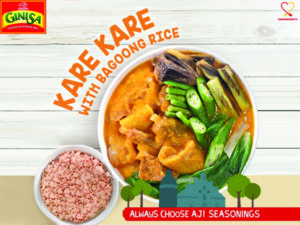
URL Copied
August 2, 2019 9:00 am

LOLA’s first riddle talks about the dish from Pampanga, considered as the Culinary Capital of the Philippines. Kare Kare is made from beef meat, tripe, and oxtail stewed in a mustard-colored peanut sauce made of annatto seeds. Vegetables are added to make it a complete, one-dish meal.
Kare kare’s history traces back to the arrival of curry brought by the Indo-Malays and the Indian Soldiers during the British Colonization between the 15th-17th century.
Whether it was the Malays or the Indians that brought curry to the Philippines, we are certain that Kare kare is a truly ulam Pinoy recipe. Through the use of local and indigent ingredients and with the technique and method of cooking, Kare kare may qualify to be a Filipino identity.
When cooking Kare kare, getting the right balance of taste, texture, and appearance is vital. To achieve this, right ingredients and techniques are needed.
Beef Meat, Tripe, and Oxtail
Using these three meat types adds to the meaty flavor of Kare kare. Tripe or “tuwalya” is a part of a beef’s stomach lining. It resembles a towel-like figure and texture, hence, tuwalya. When boiled to be tenderized, it also gelatinizes the sauce making it thick and rich.
Atchuete, Mani, Bigas and Aji-Ginisa® Flavor Seasoning Mix
Atchuete seeds, when cooked with oil or water, gives the sauce of Kare kare with its signature orange-mustard color. Ground peanuts was used as a local alternative to curry powder as the sauce’s base flavor. Ground toasted rice adds a smoky flavor and thick consistency of the sauce. Since sautéing is a vital step for Filipino cooking, Aji-Ginisa® Flavor Seasoning Mix helps in amplifying the sautéed flavor of the dish and rounding up the Kare kare experience.
Bagoong (Fermented Shrimp Paste)
Kare kare and Bagoong is a true Pinoy food pairing. Bagoong is typically used as a condiment but it can also be an integral ingredient of a dish. It is one of the many umami-rich foods that Pinoys enjoy the most. The salty-umami, and bold flavor of bagoong jives well with the subtle, and rich profile of Kare kare.
LOLA still have lots in store for you. Fly with LOLA to the Sugar Capital of the Philippines and discover their heritage dishes. Watch out for LOLA’s Bugtong ng Pagkaing Pinoy that will make you think and crave healthy recipes in the Philippines.
